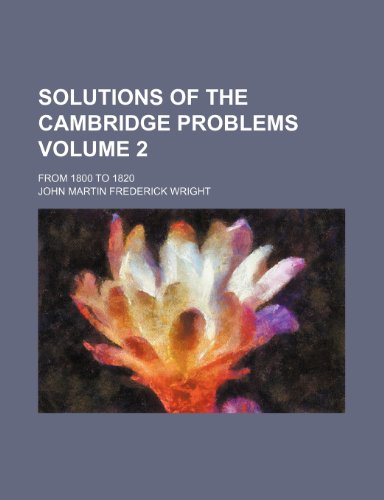Solutions of the Cambridge problems; from 1800 to 1820 Volume 2 - Softcover

Zu dieser ISBN ist aktuell kein Angebot verfügbar.
Alle Exemplare der Ausgabe mit dieser ISBN anzeigen:
Reseña del editor:
This historic book may have numerous typos and missing text. Purchasers can download a free scanned copy of the original book (without typos) from the publisher. Not indexed. Not illustrated. 1825 edition. Excerpt: ...of the contrary. The magnet consisting of two equal arms, the action of the ship's,motion upon the one is counteracted by its opposite action upon the other. 615. Generally, w being' the height of the cylinder, and p the power or weight which puts it in motion, f the radius of the base, and r the distance, then tie accelerating force on p is F=--1H pr +--t-:-.-. v = g¥t = X t Now by the question 616. Generally, required the length of a pendulum that would oscillate seconds at the distance of n radii of the Earth from its centre. If F be the force which accelerates the pendulum, whose length is L, then the time of an oscillation is got from (see Bridge, vol. II.) Hence, if I be the length of a second's pendulum at the surface of the earth, where g is the accelerating force, we hare r: t-: A Jt But by the question T = 1", and we have:' F:?:i-:: i: »'.. (hr) R1 9 9 orL = Li-If n = 2. Then L = JL = S.9 $ inches = 9.8inches. 4 4 Within the surface F = jr. JL. whence p is easily found. XV 617. Let be the distance of the particle fM from the axis of suspension, a the length of the rod, D its density at the lower extremity, L the distance between the point of suspension and centre of oscillation; then But the density at the distance x being = D.-. dM = iDx dx a 618. Generally let AC (Fig. 102,) 6e any curve whatever revolving uniformly round the vertical axis AB, and suppose the body P descending along the curve by the force of gravity; required the velocity of the body at any given epoch t. Let the ± PM = y, AM = x, BC = 0, AB =, and V the known velocity of the point C; then resolving the centrifugal force RP into the tangential and normal ones PQ, and RQ, we have PQ = PR X cos. RPQ = PR x ds and RQ, = PR x sin. RPQ = PR x--ds which...
„Über diesen Titel“ kann sich auf eine andere Ausgabe dieses Titels beziehen.
- VerlagRareBooksClub.com
- Erscheinungsdatum2012
- ISBN 10 123661562X
- ISBN 13 9781236615626
- EinbandTapa blanda
- Anzahl der Seiten94
(Keine Angebote verfügbar)
Buch Finden: Kaufgesuch aufgebenSie kennen Autor und Titel des Buches und finden es trotzdem nicht auf ZVAB? Dann geben Sie einen Suchauftrag auf und wir informieren Sie automatisch, sobald das Buch verfügbar ist!
Kaufgesuch aufgeben
